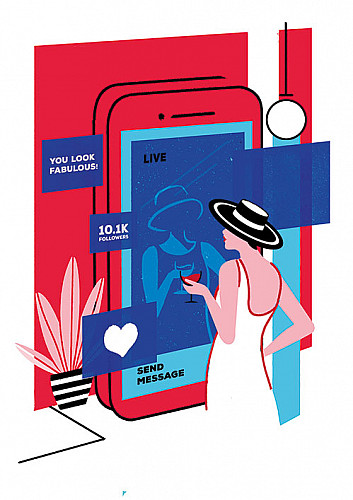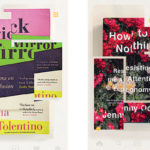How Social Media Brought The Stars Into Our Homes
We might be the last generation to remember real celebrities, those iconic figures who radiated mystique, remained untouchable and lived light years away. They shone, they were larger than life and perhaps it’s no wonder that we came to call them ‘stars’.
But today’s stars don’t live in mysterious faraway galaxies. They live in our homes with their hashtags plastered all over our Instagram feeds, their promotions on our Facebook walls, and their every opinion available on Twitter. As part of the army that follows Selena Gomez on Instagram (at 123 million, she has the world’s largest following) or Beyonce (closing in at 104 million), you know what your favourite celebrity ate for lunch (it’s commendable how a green leaf and water can imitate a four-Michelin-star meal), where she vacationed this summer and the outfit planned for tonight’s gala. Commenting on the photos, duplicating the hashtags and opining on the diet plan, yacht and outfit is expected. Social media has allowed us to come so close to the stars that we feel like we are part of the constellation.
And the stars talk back. No longer reliant on glossies to break their news or air their views, the internet gives today’s celebrity a direct megaphone to their increasingly obsessive fanbase. And so the world goes round.
It is now impossible to be a legitimate celebrity without having a formidable internet presence. Even the divine are damned; Pope Francis made waves by becoming the first pope to have an official Instagram account. President Trump insists that a “modern-day presidency” must feature his unique brand of midnight Tweets. And the British royalty recently let down their stiff upper lip to update the royal website which now includes a live Google Map showing the Queen’s location. But you don’t have to be a pope or president to be an internet sensation. Speaking in coherent sentences is not a prerequisite — at two years old, Mila Stauffer has over a million followers on Instagram; being born is unnecessary — Amal and George Clooney’s twins were trending before their birth and, actually, you don’t even need to be human — Choupette the cat gets more likes than you, about 5,000 per picture. Realising social media’s impact on global affairs, Time magazine recently released a list titled Most Influential People on the Internet. Among others, the 2017 list featured beauty blogger Huda Katan whose 20 million Instagram followers have propelled her business to stratospheric success; in Dubai (where I live) even the vending machines now sell Huda’s false eyelashes.
And this ‘digital gold rush’ isn’t just in the Arabian deserts. Kim Kardashian is one of the highest-paid stars of the internet age. Much of her private life is publicly available and while some may think airing dirty laundry (such as a nasty private spat) is in poor taste, it is actually part of a sophisticated digital strategy. Ms Kardashian is the perfect example of an internet celebrity whose core product is herself. And, at a quarter million dollars per post, she is a hugely profitable core product. Her heavily-paid-for endorsement posts are innocuously placed between a candid photo with her rapper husband Kanye and another of a fabulous yacht which makes her followers feel like they are accessing her fabulous life. And this is exactly the hook that advertisers love because it lets the product seep into the subconscious of the consumer in a way that is simply unmatched by traditional advertising.
Advertisers flock to where celebrities now live: Facebook, Twitter, Instagram and Snapchat. As Australian internet star, 19-year-old Essena O’Neill recently said, ‘If you don’t think it’s a business, you’re deluding yourself. Companies follow you with [bullet] points of what you have to say and what time you should post the photos.’ O’Neill played the game well — she achieved the ‘dream life’ of massive profits, half a million followers on Instagram and hundreds of thousands watching her every YouTube video. And yet, suddenly, she quit.
In a viral email, O’Neill detailed the charlatan world of social media. Everything is edited, airbrushed and contrived, she said, and I tend to agree. That seemingly lazy, make-up-free ‘Good morning, world!’ photo of your favourite celebrity is painstakingly composed by a team of several dozen professionals. In my own social circles, I know many who buy followers to plump up their Instagram followings and create fake accounts to post flattering comments on their own photographs. Most will use several filters and heavy-handed applications like Beauty Plus before posting a photo of their sunlit back on the beach. Perhaps O’Neill articulates it best when she describes a remarkable photo of herself on a pier in a flowing white dress looking like she’s effortlessly living la belle vie; ‘I didn’t pay for the dress,’ she says. ‘And I took countless photos trying to look hot for Instagram.’
Our impossible feeds of gorgeous celebrities, stunning beaches and memorable moments are often at crossroads with the reality of our ordinary, badly lit lives. And yet, several times in an hour, in the car, at the office, while lying on the couch, we compare our dullest moments with filtered posts from friends and contrived posts from celebrities. And it affects us in significant ways. Last year, researchers declared that time on Facebook goes hand in hand with depressive symptoms. But that was last year — an eternity in internet time. This year, a new study by the UK’s Royal Society for Public Health has found that Instagram appears to be the social network with the greatest negative effect on mental health including depression and low self-esteem. Essentially, social networks are becoming antisocial networks.
We can’t wish it away. But maybe, we can remember that the truly priceless moments are those that can never make it on to social media. I recently saw Salt Bae serve meat at Nusret, his restaurant in Dubai. With his signature cobra move, he swirled the salt crystals over our steaks. It was a distinctly underwhelming experience and yet that single move has got him over 8 million Instagram followers. What was memorable about that dinner was our reunion table of friends sharing photographs of our young children, snorting with laughter at stories of pranks played on unsuspecting schoolteachers and wondering how we got this old over endless glasses of red wine. I realised then that good times can never be captured by a post on Instagram because #friendslikefamily just doesn’t cut it.
Related posts from Verve:
Verve Trending
Sorry. No data so far.
us on Facebook to stay updated with the latest trends






